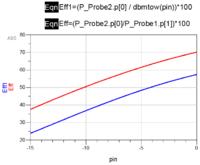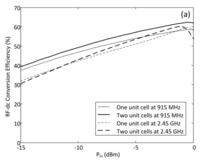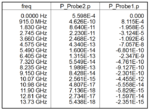circuit_hunter
Junior Member level 3

Hi
I am trying to simulate an RF rectifier discussed in an interesting work "K. Niotaki, A. Georgiadis, A. Collado and J. S. Vardakas, "Dual-Band Resistance Compression Networks for Improved Rectifier Performance," in IEEE Transactions on Microwave Theory and Techniques, vol. 62, no. 12, pp. 3512-3521, Dec. 2014." (Paper Link: ieeexplore.ieee.org/stamp/stamp.jsp?arnumber=6957619)
I have gone through many useful threads discussed in the edabaord. I have especially used guidance from "https://www.edaboard.com/threads/354542/" to setup the simulation.
My simulation setup (fig1) and the corresponding results (fig2) are attached. I have also attached the schematic (fig3) and the corresponding result (fig4) shown in the above mentioned paper:
fig1 to 4:




I have couple of questions:
(a) Since I am doing the rectifier simulation first time (after reading many threads on edaboard), please tell me if my way to simulate the circuit (that is, the simulation setup) for efficiency is correct or not.
(b) As discussed in the above thread, I have defined the efficiency in two ways: eff and eff1. How these two parameters differ? I think "eff1" should be the correct measure of efficiency as it measures efficiency with respect to the input power. I think in "eff", the reflected power is not being considered. I am not sure, please suggest correct way to define efficiency in context of RF rectifiers.
(c) Neither eff nor eff1 matches exactly with the result shown in the paper (fig4, I am considering two unit cells at 915MHz). Why is this happening? I am considering the same diodes and have taken their model parameters from the datasheet (I guess the authors have taken it from the same datasheet- perhaps the only resource available online).
Thanks in advance for your precious time.
Note: I have asked this question at other forum but couldn't get any response.
I am trying to simulate an RF rectifier discussed in an interesting work "K. Niotaki, A. Georgiadis, A. Collado and J. S. Vardakas, "Dual-Band Resistance Compression Networks for Improved Rectifier Performance," in IEEE Transactions on Microwave Theory and Techniques, vol. 62, no. 12, pp. 3512-3521, Dec. 2014." (Paper Link: ieeexplore.ieee.org/stamp/stamp.jsp?arnumber=6957619)
I have gone through many useful threads discussed in the edabaord. I have especially used guidance from "https://www.edaboard.com/threads/354542/" to setup the simulation.
My simulation setup (fig1) and the corresponding results (fig2) are attached. I have also attached the schematic (fig3) and the corresponding result (fig4) shown in the above mentioned paper:
fig1 to 4:




I have couple of questions:
(a) Since I am doing the rectifier simulation first time (after reading many threads on edaboard), please tell me if my way to simulate the circuit (that is, the simulation setup) for efficiency is correct or not.
(b) As discussed in the above thread, I have defined the efficiency in two ways: eff and eff1. How these two parameters differ? I think "eff1" should be the correct measure of efficiency as it measures efficiency with respect to the input power. I think in "eff", the reflected power is not being considered. I am not sure, please suggest correct way to define efficiency in context of RF rectifiers.
(c) Neither eff nor eff1 matches exactly with the result shown in the paper (fig4, I am considering two unit cells at 915MHz). Why is this happening? I am considering the same diodes and have taken their model parameters from the datasheet (I guess the authors have taken it from the same datasheet- perhaps the only resource available online).
Thanks in advance for your precious time.
Note: I have asked this question at other forum but couldn't get any response.











